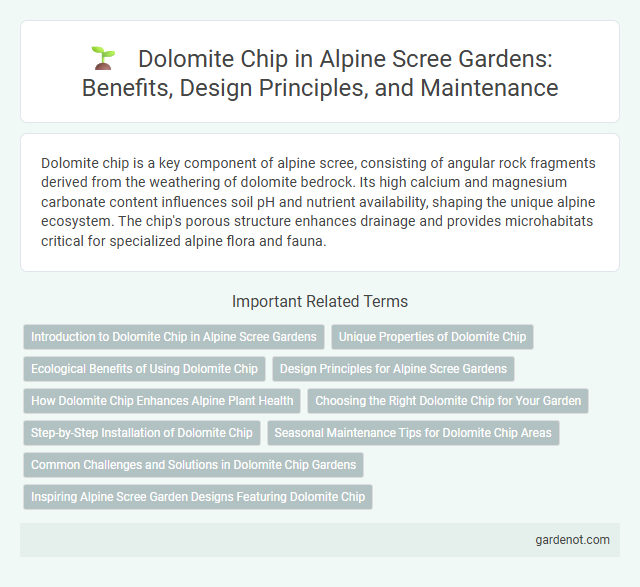Dolomite chip is a key component of alpine scree, consisting of angular rock fragments derived from the weathering of dolomite bedrock. Its high calcium and magnesium carbonate content influences soil pH and nutrient availability, shaping the unique alpine ecosystem. The chip's porous structure enhances drainage and provides microhabitats critical for specialized alpine flora and fauna.
Introduction to Dolomite Chip in Alpine Scree Gardens
Dolomite chip, a naturally occurring sedimentary rock rich in calcium magnesium carbonate, is commonly used in Alpine scree gardens to enhance soil alkalinity and improve drainage. Its durable, angular particles create a stable substrate that supports the growth of alpine plants adapted to well-drained, mineral-rich environments. Incorporating dolomite chip into scree gardens mimics the natural rocky terrain of the Dolomite Mountains, promoting healthier root development and vibrant plant growth.
Unique Properties of Dolomite Chip
Dolomite chip, a distinctive component of Alpine scree, exhibits exceptional durability and resistance to weathering due to its high magnesium carbonate content. Its angular shape enhances soil stability and drainage, making it crucial for ecological habitats and construction applications in mountainous terrain. The unique chemical composition of dolomite chip also contributes to its ability to neutralize acidic soils, supporting diverse alpine plant life.
Ecological Benefits of Using Dolomite Chip
Dolomite chip enhances soil quality by releasing essential nutrients such as calcium and magnesium, which promote healthy plant growth in alpine scree environments. Its natural ability to improve soil pH helps restore ecological balance, supporting diverse alpine flora and fauna adapted to these conditions. Using dolomite chip reduces the need for chemical fertilizers, leading to a more sustainable and environmentally friendly approach to managing alpine ecosystems.
Design Principles for Alpine Scree Gardens
Dolomite chip enhances Alpine scree gardens by providing excellent drainage and a neutral pH balance that mimics natural mountain conditions, promoting healthy root development for alpine plants. Its angular texture creates interlocking layers that stabilize slopes and prevent soil erosion in steep scree environments. The durability and light color of Dolomite chip reflect sunlight, reducing heat stress and supporting optimal growth for drought-tolerant species typical of alpine ecosystems.
How Dolomite Chip Enhances Alpine Plant Health
Dolomite chip improves Alpine plant health by supplying essential magnesium and calcium, which regulate nutrient absorption and strengthen cell walls. Its alkaline nature neutralizes acidic soil conditions, creating a balanced pH that promotes robust root development in scree environments. Enhanced soil aeration from dolomite chip also supports microbial activity crucial for nutrient cycling in Alpine ecosystems.
Choosing the Right Dolomite Chip for Your Garden
Selecting the right Dolomite chip for your Alpine scree garden enhances soil pH balance and nutrient availability, crucial for plant health. Opt for fine-grain Dolomite chips to improve drainage and prevent waterlogging, while larger chips help retain moisture and reduce erosion. Ensure the chips are high in calcium magnesium carbonate to support sustainable soil conditioning and promote thriving Alpine vegetation.
Step-by-Step Installation of Dolomite Chip
Installing Dolomite chip on Alpine scree involves first clearing and leveling the scree surface to ensure stability and proper drainage. Next, spread a geotextile fabric over the scree to prevent weed growth and maintain soil separation, then evenly distribute the Dolomite chip layer to a depth of 2-3 inches for optimal coverage and aesthetic appeal. Compact the chips gently with a roller or tamper to settle them into place, creating a durable, erosion-resistant ground cover ideal for alpine landscaping.
Seasonal Maintenance Tips for Dolomite Chip Areas
Regular seasonal maintenance of Dolomite chip areas in Alpine scree environments involves thorough cleaning to remove debris and prevent moss growth that can degrade the stone's surface. Applying a breathable sealant in spring enhances durability against freeze-thaw cycles common in mountainous regions. Periodic replenishment of Dolomite chips ensures stable ground cover and preserves aesthetic quality throughout the year.
Common Challenges and Solutions in Dolomite Chip Gardens
Dolomite chip gardens often face challenges such as poor drainage, nutrient deficiencies, and soil alkalinity, which can hinder plant growth. To address these issues, incorporating organic matter and selecting drought-tolerant, alkalinity-resistant plants improve soil structure and plant health. Regular soil testing combined with appropriate amendments like sulfur or iron sulfate helps maintain balanced pH levels and nutrient availability in Alpine scree environments.
Inspiring Alpine Scree Garden Designs Featuring Dolomite Chip
Dolomite chip is prized for its durable, smooth texture and natural gray-white hues that perfectly mimic authentic Alpine scree environments. Its high calcium magnesium carbonate content ensures excellent drainage and pH balance, creating ideal conditions for alpine plants to thrive. Incorporating dolomite chip in garden designs enhances visual appeal while supporting sustainable, low-maintenance landscapes inspired by mountainous terrains.
Dolomite chip Infographic

 gardenot.com
gardenot.com